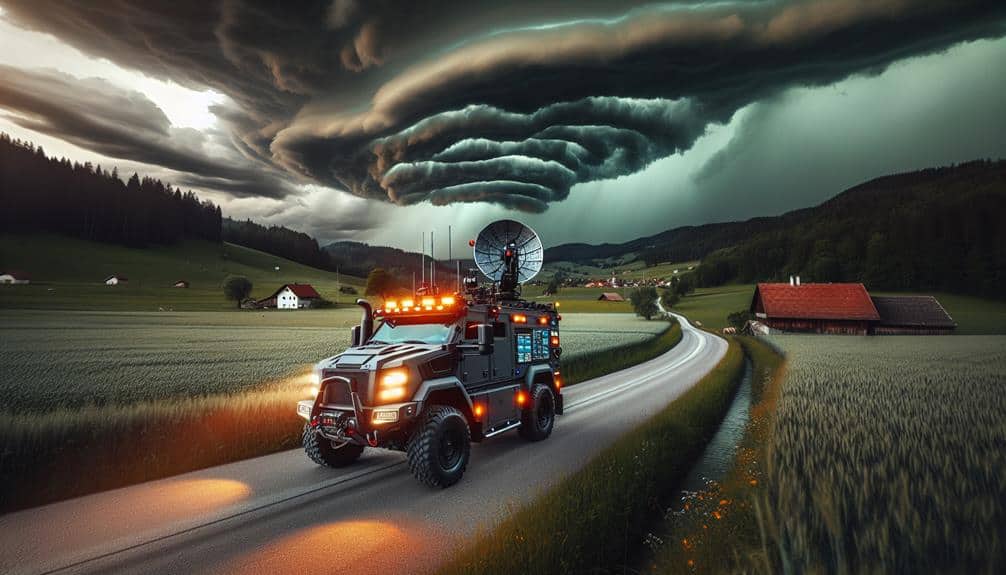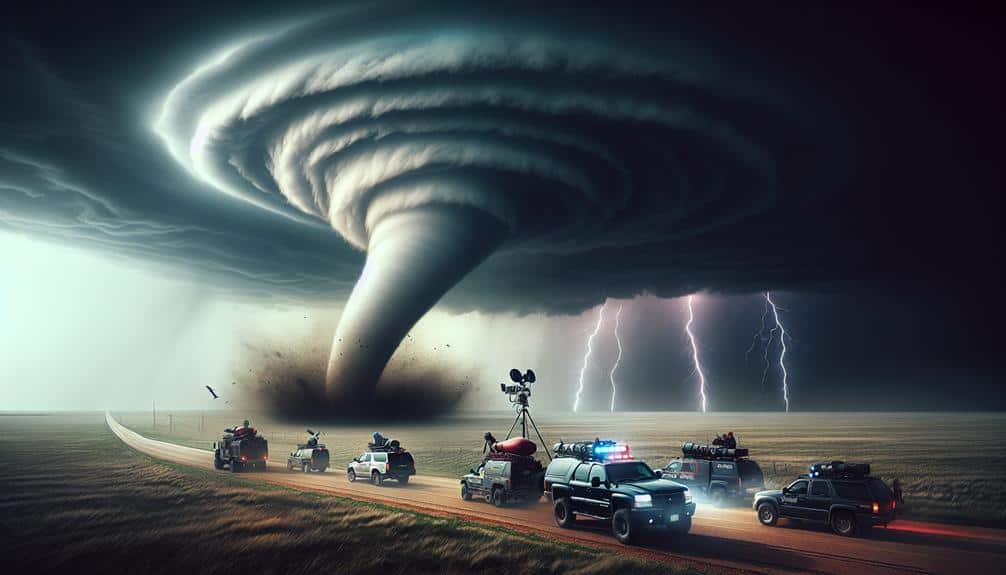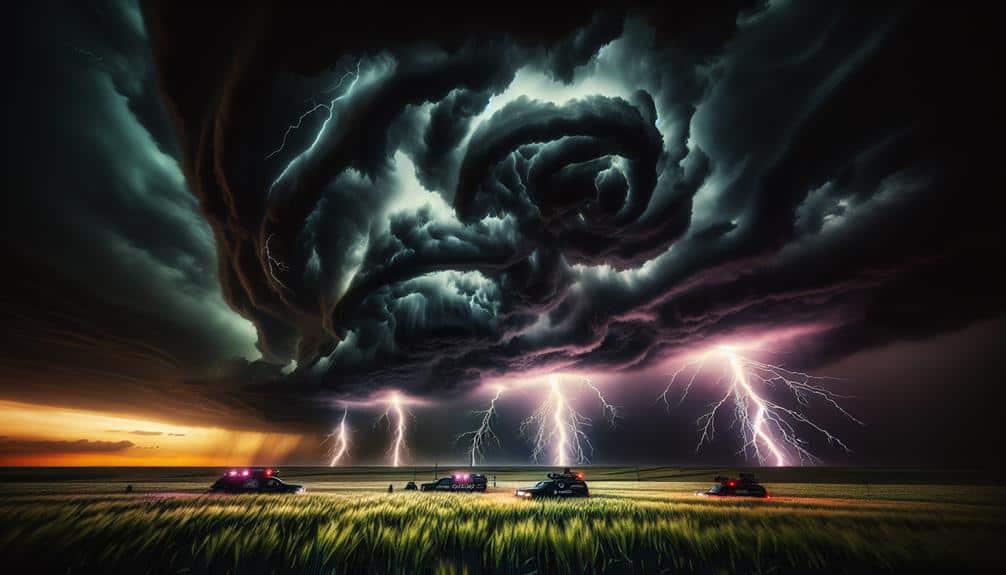Storm chasing contests have a significant environmental impact. We see increased greenhouse emissions due to extensive vehicle travel, often with fuel-inefficient cars. Wildlife suffers from heightened stress and habitat disruption, while native plants experience trampling and soil erosion. Waste and pollution spike as single-use plastics and improperly disposed batteries accumulate. Additionally, noise pollution from vehicle engines disrupts both local communities and wildlife. Ethical issues arise from safety risks and strained local resources. Balancing enthusiasm for storm chasing with these environmental concerns is essential, and exploring effective mitigation strategies will shed light on sustainable practices.
Key Points
- Storm chasing contests significantly increase greenhouse gas emissions due to extensive vehicle use and long-distance travel.
- Wildlife experiences increased stress, habitat fragmentation, and behavioral disruptions from human presence and vehicle noise.
- Vehicular activity causes soil erosion, loss of nutrient-rich topsoil, and damage to native plants, reducing biodiversity and plant biomass.
- Improper disposal of single-use plastics and high-tech equipment batteries leads to pollution and environmental degradation.
Carbon Footprint of Travel
When we examine the carbon footprint of travel associated with storm chasing contests, the data shows a significant increase in greenhouse gas emissions due to extensive vehicle use and frequent long-distance trips. Each journey, often undertaken with fuel-inefficient vehicles, contributes significantly to our overall carbon footprint.
To mitigate these impacts, we should consider sustainable transportation options. Electric or hybrid vehicles can greatly reduce emissions, even though they might initially seem less convenient for the unpredictable nature of storm chasing. Using renewable energy sources to charge these vehicles can further lessen the environmental burden.
Another viable strategy involves offsetting emissions. By investing in carbon offset programs, we can balance the emissions generated by travel. It's a practical step that aligns with our desire for freedom while being conscious of our environmental responsibilities.
Remote monitoring and virtual participation offer innovative solutions to reduce our dependence on physical travel. Advances in technology now allow us to observe and analyze storm data from a distance. By incorporating these methods, we can minimize our carbon footprint without sacrificing the excitement and scientific value of storm chasing. This balanced approach guarantees we enjoy our passion sustainably.
Disturbance to Wildlife
Storm chasing contests often disrupt local wildlife habitats, causing stress and potential harm to various species. Participants in these events frequently travel through remote areas, inadvertently causing habitat destruction and wildlife displacement. The loud noises from vehicles and the presence of humans can be particularly distressing for animals, leading to disrupted feeding and breeding patterns.
It's essential to contemplate how these disturbances affect the ecosystem. Here are some impacts we've observed:
- Increased Stress Levels: Animals exhibit heightened stress responses due to constant human presence and vehicle noise.
- Disruption of Natural Behaviors: Regular activities such as foraging, mating, and nesting are interrupted.
- Habitat Fragmentation: Frequent movement through certain areas can lead to fragmented habitats, making it difficult for species to thrive.
- Direct Harm: There's a risk of physical harm to animals if vehicles inadvertently collide with them.
Understanding these impacts is vital for us to balance our freedom to engage in storm chasing with the need to protect wildlife. Responsible practices and stringent regulations can help mitigate these adverse effects, ensuring that our pursuits don't come at the expense of the environment.
Impact on Vegetation
We need to ponder how storm chasing contests contribute to the trampling of native plants, often leading to decreased biodiversity. Data shows that increased foot and vehicle traffic in sensitive areas exacerbates soil erosion.
This erosion not only destabilizes plant life but also impacts the broader ecosystem.
Trampled Native Plants
The frequent movement of storm chasers across various terrains results in the significant trampling of native plants, leading to a measurable decline in local vegetation health. By traversing delicate ecosystems, we're inadvertently causing habitat destruction and ecosystem damage. The impact isn't just essential; it's quantifiable.
Studies indicate that repeated disturbances lead to a decrease in plant diversity and biomass. Our presence in these areas can disrupt the natural growth cycles of native species. The trampling compacts the soil, making it difficult for roots to penetrate and for water to be absorbed effectively. This, in turn, reduces the resilience of these plants to other environmental stressors.
- Reduction in plant biodiversity
- Decreased plant biomass
- Compaction of soil affecting root growth
- Disruption of natural plant cycles
These points illustrate how storm chasing activities contribute to the overall degradation of vegetation. We must consider the long-term effects of our actions on these delicate ecosystems.
While the thrill of the chase is undeniable, it's vital to balance our pursuits with the need to preserve the integrity of the natural landscapes we traverse.
Soil Erosion Concerns
In addition to trampling native plants, our constant movement across landscapes exacerbates soil erosion, further impacting vegetation health. Studies show that frequent vehicular activity on unpaved roads increases soil displacement by up to 60%.
This erosion strips away nutrient-rich topsoil, essential for plant growth, leading to reduced vegetative cover and increased vulnerability to future erosion.
To mitigate these impacts, we need to focus on erosion prevention and conservation efforts. For instance, implementing designated pathways for storm chasing vehicles can minimize widespread soil disturbance. Research indicates that controlled access routes can reduce erosion rates by as much as 40%.
Additionally, re-vegetation projects and the use of erosion control mats can stabilize the soil, fostering a more resilient ecosystem.
Moreover, educating participants about the environmental consequences of their activities is vital. If we prioritize awareness and adopt sustainable practices, we can balance our pursuit of storm data with the preservation of our natural landscapes.
Waste and Pollution
Storm chasing contests generate significant waste and pollution due to the extensive use of vehicles and equipment. As we navigate through various terrains, the environmental footprint expands with each mile. Plastic usage is rampant, from disposable water bottles to packaging for equipment. Despite the excitement, we must contemplate the sustainability of our actions.
Waste management systems are often stretched thin during these events. Recycling efforts, though present, are insufficient given the volume of waste produced. Here are key points to ponder:
- Vehicle Emissions: The fuel consumption of multiple vehicles contributes heavily to air pollution.
- Plastic Waste: Single-use plastics, such as bottles and wrappers, accumulate rapidly.
- Battery Disposal: High-tech equipment uses batteries, which, if not disposed of correctly, can harm ecosystems.
- Abandoned Gear: Broken or outdated equipment is sometimes left behind, adding to environmental degradation.
To secure our freedom to chase storms responsibly, we need to ramp up our recycling efforts and improve waste management strategies. Reducing plastic usage and managing our environmental footprint can help preserve the natural landscapes we so eagerly explore.
Noise Pollution

We should consider the noise pollution generated by storm chasing contests, particularly from vehicle engine noise. Data shows that this constant noise disrupts local wildlife, causing stress and altering their natural behaviors.
Vehicle Engine Noise
The incessant roar of multiple vehicle engines during storm chasing contests contributes significantly to noise pollution in otherwise peaceful rural areas. This disruption affects local communities and the environment. By analyzing the data, we can better understand the implications and take steps to mitigate the impact.
Community engagement is essential in understanding and addressing the concerns of residents affected by storm chasing activities. By involving them in discussions and decision-making, we can develop strategies that balance our pursuit of freedom with their right to a tranquil environment. Implementing safety protocols, such as designated safe zones and noise reduction measures, can further protect both participants and residents.
To highlight the key points:
- High decibel levels: Engine noise can exceed 85 decibels, impacting hearing and well-being.
- Sleep disruption: Continuous noise interferes with sleep patterns, affecting health.
- Communication barriers: Excessive noise hampers local communication and emergency responses.
- Mental health: Persistent noise pollution can lead to increased stress and anxiety.
Disruption to Wildlife
Amid the cacophony of engine noise, wildlife experiences significant disruption, leading to altered behaviors and potential habitat displacement. When storm chasers converge on an area, the sudden influx of vehicles and human activity can result in habitat destruction. This disruption forces animals to leave their established territories, which can be particularly detrimental during critical periods such as breeding seasons.
Studies have shown that noise pollution can cause breeding disruptions and nesting interference. Birds, for instance, rely on vocalizations for mating calls and territory defense. When engine noise drowns out these calls, it can lead to a decrease in successful mating, directly impacting population levels.
Mammals, too, are affected; their stress levels can increase due to constant noise, leading to altered feeding and movement patterns.
Additionally, the displacement of animals from their habitats can have a cascading effect on the ecosystem. Predators may find it harder to locate prey, while prey species may become more vulnerable in unfamiliar environments. This chain reaction underscores the need for careful consideration of the environmental impacts of storm chasing contests.
Ethical Considerations
Evaluating the ethical considerations of storm chasing contests necessitates a thorough examination of the potential environmental and societal impacts. We must analyze how these events affect both participant safety and community engagement.
Data indicates that storm chasing can place participants in hazardous situations, increasing the likelihood of injury or fatality. These contests often require participants to drive long distances, which has an environmental footprint concerning fuel consumption and emissions.
Equally important is the impact on local communities. Storm chasers can inadvertently strain local resources like emergency services, which might already be stretched thin during extreme weather events. Additionally, the presence of multiple vehicles and people can disrupt local traffic and potentially jeopardize the safety of residents.
To address these ethical concerns, we should consider:
- Participant safety: Are adequate measures in place to protect those involved?
- Environmental footprint: How much fuel and resources are being consumed?
- Community engagement: Are local communities consulted and involved in the planning?
- Emergency services: How do storm chasing contests impact local emergency response capabilities?
Frequently Asked Questions
How Do Storm Chasing Contests Affect Local Communities and Economies?
Storm chasing contests boost local economies through increased tourism development and strengthen community relations. However, they also raise environmental concerns due to potential damage and strain on resources. Balancing economic impact with environmental sustainability is vital.
Are There Any Regulations Governing Storm Chasing Contests?
When we dig into the regulations governing storm chasing contests, we find minimal oversight. This lack of regulation impacts both safety and environmental concerns, highlighting a Wild West scenario where freedom reigns but risks are significant.
What Safety Measures Are in Place for Participants in Storm Chasing Contests?
We've implemented strict safety protocols, participant training, and equipment requirements to guarantee everyone's safety. Emergency response teams are always on standby. These measures minimize risks and let us enjoy the freedom of storm chasing responsibly.
How Does Media Coverage Influence the Popularity of Storm Chasing Contests?
Ever wonder how media influence skyrockets the popularity of storm chasing contests? Social media's engagement metrics reveal a massive surge in interest. Data shows that enthralling coverage and real-time updates drive audience numbers, fueling widespread fascination.
What Is the Role of Technology in Modern Storm Chasing Contests?
We rely on technological advancements to enhance safety and improve data collection during storm chasing contests. These tools aid in more accurate forecasting, allowing us to predict storm paths better and make informed decisions in real-time.


